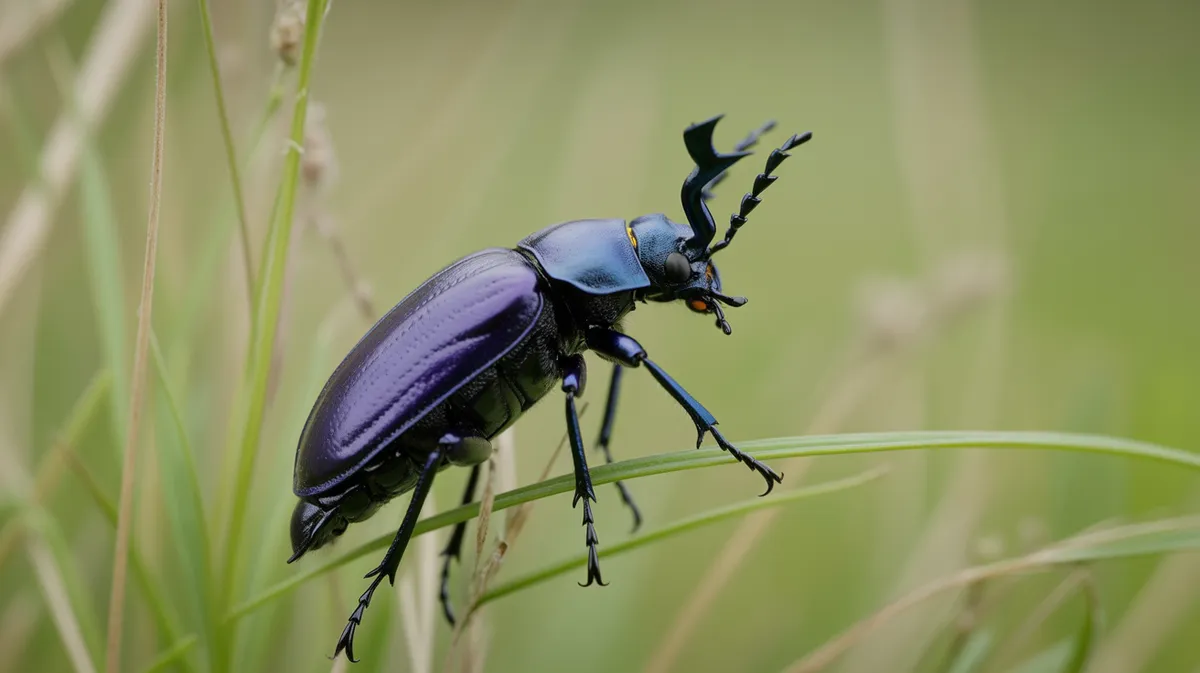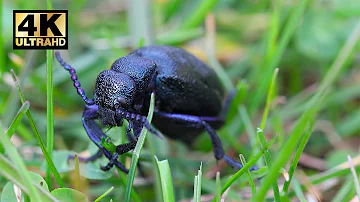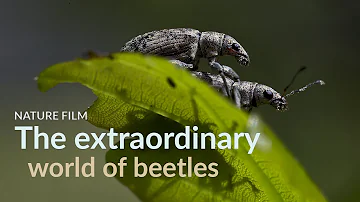
Violet Oil Beetle
Meloe violaceus

Meet the Violet Oil Beetle
The Violet Oil Beetle is a striking invertebrate known for its metallic blue-violet coloration and unusually large, soft body. Found across Europe and parts of western Asia, this beetle is most often seen in spring, wandering meadows and woodland edges. Notably, its larvae are parasitic, relying on solitary bees for part of their development. The adult beetle exudes a toxic oily substance called cantharidin as a defense mechanism, which can cause skin irritation in humans. Their presence is often an indicator of healthy, undisturbed habitats.
Classification
Invertebrate
Habitat
Meadows, woodland edges, and grasslands
Diet
Omnivore
Lifespan
1-2 years
Conservation
Near Threatened
Weight
0.5–2 grams
📖Fascinating Facts
Shimmering Armor
The beetle's vibrant violet-blue color is created by microscopic surface structures that reflect light, not by pigments.
Bee Parasite
Violet oil beetle larvae mimic the scent of female bees to attach themselves to visiting pollinators, gaining a ride to the bees’ nests.
Toxic Defense
When threatened, the beetle secretes cantharidin, a potent chemical that deters most predators and can cause blistering in humans.
📋Detailed Description
The Violet Oil Beetle (Meloe violaceus) is a large, flightless beetle belonging to the family Meloidae, with adults typically measuring between 15 and 35 mm in length. Its most distinguishing feature is the iridescent, metallic blue-violet coloration of its elytra and thorax, which are soft and loosely cover the abdomen, unlike the hard wing cases of most beetles. The abdomen is notably swollen and segmented, especially in gravid females, giving the beetle a distinctive, bulbous appearance. The head is relatively small with pronounced, curved antennae and strong mandibles adapted for feeding on plant material. Adults are slow-moving and rely on chemical defenses rather than speed or agility. The species exhibits hypermetamorphosis: its larvae (triungulins) are highly mobile and parasitic, seeking out solitary bee nests to complete their development. Adults are most active in spring, often seen wandering in search of mates or oviposition sites. The beetle's life cycle is closely tied to the presence of solitary bees, making it an important indicator of pollinator diversity and ecosystem health. The excretion of cantharidin, a potent blistering agent, serves as a defense against predators and is a hallmark of the Meloidae family.
💡 Did you know?
Despite their eye-catching appearance, adult violet oil beetles are flightless and rely entirely on walking to move between habitats.
🔬Research & Sources
🎭Behavior & Social Structure
Meloe violaceus adults are primarily diurnal and solitary, spending much of their time walking slowly through vegetation in search of food or mates. They feed on a variety of herbaceous plants, including buttercups and dandelions, consuming leaves, flowers, and stems. The beetle is not an active hunter, but may opportunistically feed on small invertebrates or decaying organic matter. When threatened, it exhibits thanatosis (feigning death) or exudes yellowish droplets of cantharidin-laden hemolymph from its joints, deterring predators such as birds and small mammals. Social interactions are limited to brief courtship and mating encounters. Larvae display a unique phoretic behavior: after hatching, triungulins climb onto flowers and attach themselves to visiting bees, which inadvertently transport them to their nests.
👶Reproduction & Life Cycle
Reproduction occurs in spring, with males locating females by following pheromonal cues. Courtship involves the male mounting the female and transferring a spermatophore. Females lay hundreds to thousands of eggs in shallow burrows or loose soil. After hatching, the triungulin larvae climb onto flowers and await solitary bees. Upon attachment, they are carried to the bee’s nest, where they consume the bee egg and stored pollen and nectar. The larval stage involves several metamorphic phases, with the final instar pupating within the bee nest. There is typically one generation per year (univoltine), and there is no parental care beyond egg-laying.
🛡️Adaptations & Survival
Meloe violaceus exhibits several remarkable adaptations. The production of cantharidin provides a potent chemical defense, making the beetle unpalatable and hazardous to many would-be predators. The hypermetamorphic life cycle, with highly mobile triungulin larvae, is a specialized adaptation for exploiting solitary bee nests, ensuring larval development in a nutrient-rich, protected environment. The beetle’s flightlessness is compensated by its robust chemical defenses and cryptic coloration, which blends with the ground and vegetation. The soft, expandable abdomen allows for high fecundity in females, supporting the production of large egg batches. Behavioral adaptations such as thanatosis and phoresy further enhance survival and reproductive success.
📚Research Sources
🎨Cultural Significance
Historically, oil beetles, including Meloe violaceus, have been noted in European folklore for their striking appearance and toxic properties. Cantharidin, the blistering agent they produce, was once harvested for use in traditional medicine and as an aphrodisiac (notably as 'Spanish fly'), though such uses are now recognized as dangerous and largely abandoned. The beetle’s presence is sometimes seen as an indicator of healthy, undisturbed countryside, and it features in natural history literature as a symbol of ecological interdependence. There are no widespread myths or symbolic uses specific to this species, but its unique life cycle is often cited in educational contexts to illustrate parasitism and insect-plant-pollinator relationships.
🔬Recent Research & Discoveries
Recent research has focused on the ecological interactions between Meloe violaceus and solitary bees, with studies highlighting the beetle’s dependence on specific bee hosts and the implications for conservation. Molecular analyses have clarified the phylogenetic relationships within the Meloidae family, and chemical studies continue to investigate the biosynthesis and ecological role of cantharidin. Ongoing monitoring projects in Europe are tracking population trends in response to changing agricultural practices and pollinator declines. There is also interest in the beetle’s potential as a bioindicator for habitat quality and pollinator health. Notably, recent studies have documented local extinctions in areas with intensive land use, underscoring the need for targeted conservation action.
🎥Wildlife Videos

4K Ultra HD Video || Poisonous violet oil beetle feeding on grass
Amazing world is a channel which produced raw videos from beautiful locations in the world. Natural beauty is our main priority.
CatBuzz

THE OIL BEETLE OASIS - a film by Valentin Blüml
The oil beetle is a truly unique and fascinating species, found in the middle of Europe. While they are known for their powerful ...
Valentin Blüml

The extraordinary world of beetles
Beetles are one of the most numerous orders of insects. They come in all shapes and sizes. They inhabit a variety of habitats.
Forest Film Studio

Africa's Dung Beetles: The Ultimate Recyclers | Wildlife Icons Ep103
There are more species of beetle in the world than any other animal, and few play a role as important as the humble dung beetle.
Love Nature

The Insane Toxin of the American Oil Beetle // Creepy Crawlies
Today we find a species of blister beetle called the American Oil Beetle (Meloe americanus). Blister beetles excrete a toxic ...
Pinpoint Wildlife

The violet oil Beetle
Meloe violaceus, the violet oil beetle, is a species of oil beetle belonging to the family Meloidae. These beetles are present in most ...
KosaBrin
🌍Habitat Information
The Violet Oil Beetle typically inhabits Meadows, woodland edges, and grasslands environments. Violet Oil Beetles have adapted to their environments with specialized features and behaviors.
Primary Habitat:
Meadows, woodland edges, and grasslands
More detailed habitat information will be available soon.
🛡️Conservation Status
The Violet Oil Beetle is currently classified as Near Threatened. Conservation efforts are crucial for preserving this species for future generations.
Common Threats:
- 🏠Habitat loss and fragmentation
- 🌡️Climate change impacts
- 🎯Hunting and poaching
- 🏭Human-wildlife conflict
⚠️Threats & Conservation Challenges
The Violet Oil Beetle faces several conservation challenges, primarily due to habitat loss, agricultural intensification, and declines in solitary bee populations. The species is sensitive to changes in land management, pesticide use, and the fragmentation of meadows and grasslands. As its larvae are obligate parasites of solitary bees, any factors reducing bee diversity or abundance directly impact beetle populations. Roadside mowing, overgrazing, and urban development further threaten suitable habitats. Population trends indicate regional declines, leading to its Near Threatened status in parts of its range. Conservation efforts focus on protecting traditional meadows, promoting pollinator-friendly practices, and monitoring beetle and bee populations.
🔬Scientific Classification
Scientific Name
Meloe violaceus
Classification Hierarchy
🔍 About Taxonomic Classification
Taxonomic classification is a hierarchical system used by scientists to classify and organize living organisms based on shared characteristics and evolutionary relationships.
The system moves from broad categories (Kingdom) to increasingly specific ones, with each animal's scientific name typically consisting of its Genus and species.
📝Community Notes
Share your observations and insights about the Violet Oil Beetle with our community of wildlife enthusiasts.
Join Our Community
Sign in to share your observations and connect with fellow wildlife enthusiasts.
Sign In to ContributeNo community notes yet
Be the first to share your observations about the Violet Oil Beetle!
Explore Violet Oil Beetle
Select a tab above to learn more about this amazing animal.
📸Photo Gallery
No photos available for this animal yet.
🌟Discover More Wildlife
Continue your journey of discovery with more fascinating animals from our database
